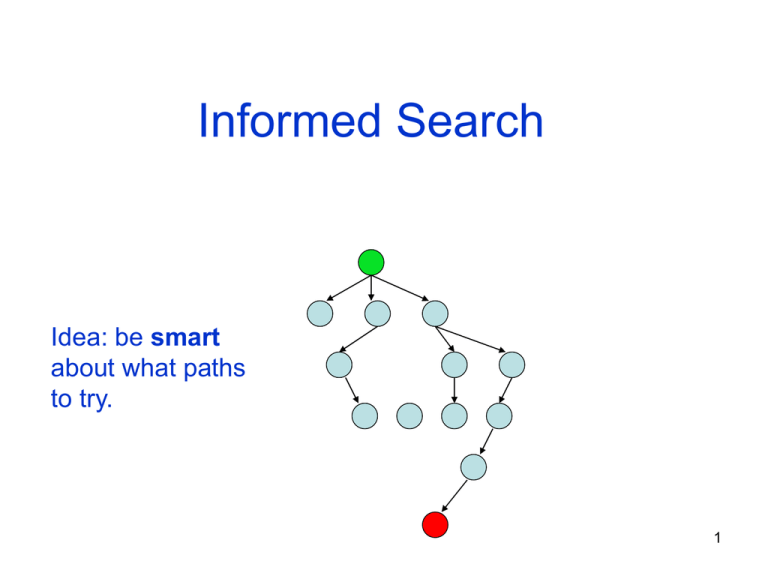search algorithms
advertisement

Informed Search
Idea: be smart
about what paths
to try.
1
Expanding a Node
successor
list
How should we implement this?
2
Blind Search vs. Informed Search
• What’s the difference?
• How do we formally specify this?
3
General Tree Search Paradigm
(adapted from Chapter 3)
function tree-search(root-node)
fringe successors(root-node)
while ( notempty(fringe) )
{node remove-first(fringe)
state state(node)
if goal-test(state) return solution(node)
fringe insert-all(successors(node),fringe) }
return failure
end tree-search
Does this look familiar?
4
General Graph Search Paradigm
(adapted from Chapter 3)
function graph-search(root-node)
closed { }
fringe successors(root-node)
while ( notempty(fringe) )
{node remove-first(fringe)
state state(node)
if goal-test(state) return solution(node)
if notin(state,closed)
{add(state,closed)
fringe insert-all(successors(node),fringe) }}
return failure
end graph-search
What’s the difference between this and tree-search?
5
Tree Search or Graph Search
• What’s the key to the order of the search?
6
Best-First Search
• Use an evaluation function f(n).
• Always choose the node from fringe that
has the lowest f value.
3
5
1
7
Best-First Search Example
3
5
1
4
6
8
Old Friends
• Breadth first = best first
– with f(n) = depth(n)
• Dijkstra’s Algorithm = best first
– with f(n) = g(n)
– where g(n) = sum of edge costs from start to n
– space bound (stores all generated nodes)
9
Heuristics
• What is a heuristic?
• What are some examples of heuristics we
use?
• We’ll call the heuristic function h(n).
10
Greedy Best-First Search
•
•
•
•
•
f(n) = h(n)
What does that mean?
Is greedy search optimal?
Is it complete?
What is its worst-case complexity for a
tree with branching factor b and maximum
depth m?
11
A* Search
• Hart, Nilsson & Rafael 1968
– Best first search with f(n) = g(n) + h(n)
where g(n) = sum of edge costs from start to n
and h(n) = estimate of lowest cost path n-->goal
– If h(n) is admissible then search will find optimal
solution.
{
Space bound since the queue must be maintained.
12
start
Shortest Path Example
end
13
A* Shortest Path Example
14
A* Shortest Path Example
15
A* Shortest Path Example
16
A* Shortest Path Example
17
A* Shortest Path Example
18
A* Shortest Path Example
19
8 Puzzle Example
• f(n) = g(n) + h(n)
• What is the usual g(n)?
• two well-known h(n)’s
– h1 = the number of misplaced tiles
– h2 = the sum of the distances of the tiles from
their goal positions, using city block distance,
which is the sum of the horizontal and vertical
distances
20
8 Puzzle Using Number of
Misplaced Tiles
1 2 3
8
4
7 6 5
goal
1st 2 8 3
1 6 4
7
5
5+1=6
2 8 3
1 6 4
7 5
2nd 2 8 3
4 1
4
7 6 5
5
2 8 3
1 4
7 6 5
2
3
5 1 8 4
7 6 5
0+4=4
6
2 8 3
1 6 4
7 5
6
2 8 3
1 4
7 6 5
21
Continued
22
Optimality of A*
Suppose a suboptimal goal G2 has been generated and
is in the queue. Let n be an unexpanded node on the
shortest path to an optimal goal G1.
f(n) = g(n) + h(n)
< g(G1)
< g(G2)
= f(G2)
n
G1
G2
Why?
G2 is suboptimal
f(G2) = g(G2)
So f(n) < f(G2) and A* will never select
G2 for expansion.
23
Algorithms for A*
• Since Nillsson defined A* search, many different
authors have suggested algorithms.
• Using Tree-Search, the optimality argument
holds, but you search too many states.
• Using Graph-Search, it can break down,
because an optimal path to a repeated state can
be discarded if it is not the first one found.
• One way to solve the problem is that whenever
you come to a repeated node, discard the longer
path to it.
24
The Rich/Knight Implementation
• a node consists of
– state
– g, h, f values
– list of successors
– pointer to parent
• OPEN is the list of nodes that have been generated and
had h applied, but not expanded and can be
implemented as a priority queue.
• CLOSED is the list of nodes that have already been
expanded.
25
Rich/Knight
1)
/* Initialization */
OPEN <- start node
Initialize the start node
g:
h:
f:
CLOSED <- empty list
26
Rich/Knight
2) repeat until goal (or time limit or space limit)
•
•
•
•
if OPEN is empty, fail
BESTNODE <- node on OPEN with lowest f
if BESTNODE is a goal, exit and succeed
remove BESTNODE from OPEN and add it to
CLOSED
• generate successors of BESTNODE
27
Rich/Knight
for each successor s do
1. set its parent field
2. compute g(s)
3. if there is a node OLD on OPEN with
the same state info as s
{ add OLD to successors(BESTNODE)
if g(s) < g(OLD), update OLD and
throw out s }
28
Rich/Knight
4. if (s is not on OPEN and there is a node
OLD on CLOSED with the same state
info as s
{ add OLD to successors(BESTNODE)
if g(s) < g(OLD), update OLD,
throw out s,
***propagate the lower costs to
successors(OLD) }
That sounds like a LOT of work. What could we do instead?
29
Rich/Knight
5. If s was not on OPEN or CLOSED
{ add s to OPEN
add s to successors(BESTNODE)
calculate g(s), h(s), f(s) }
end of repeat loop
30
The Heuristic Function h
• If h is a perfect estimator of the true cost then A* will
always pick the correct successor with no search.
• If h is admissible, A* with TREE-SEARCH is guaranteed
to give the optimal solution.
• If h is consistent, too, then GRAPH-SEARCH without
extra stuff is optimal.
h(n) < c(n,a,n’) + h(n’) for every node n and each of
its successors n’ arrived at through action a.
• If h is not admissable, no guarantees, but it can work
well if h is not often greater than the true cost.
31



